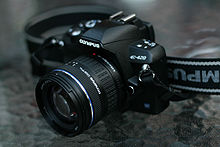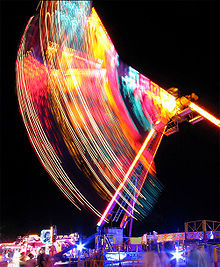Digital photography
A handheld digital camera, Canon Ixusclass.
Olympus E-420 Four Thirds entry-levelDSLR.
The Nikon D1, the first DSLR to truly compete with, and begin to replace, film cameras in the professional photojournalism and sports photography fields.
Nikon DSLR and scanner, which converts film images to digital
Sony Ericsson K800i camera phone.
Manual shutter control and exposuresettings can achieve unusual results.
Main article: Digital photography
See also: Digital versus film photography
Traditional photography burdened photographers working at remote locations without easy access to processing facilities, and competition from television pressured photographers to deliver images to newspapers with greater speed. Photo journalists at remote locations often carried miniature photo labs and a means of transmitting images through telephone lines. In 1981, Sony unveiled the first consumer camera to use a charge-coupled device for imaging, eliminating the need for film: the Sony Mavica. While the Mavica saved images to disk, the images were displayed on television, and the camera was not fully digital. In 1990, Kodak unveiled the DCS 100, the first commercially available digital camera. Although its high cost precluded uses other than photojournalism and professional photography, commercial digital photography was born.
Digital imaging uses an electronic image sensor to record the image as a set of electronic data rather than as chemical changes on film. The primary difference between digital and chemical photography is that chemical photography resists manipulation because it involves film andphotographic paper, while digital imaging is a highly manipulative medium. This difference allows for a degree of image post-processing that is comparatively difficult in film-based photography and permits different communicative potentials and applications.
Digital point-and-shoot cameras have become widespread consumer products, outselling film cameras, and including new features such as video and audio recording. Kodak announced in January 2004 that it would no longer sell reloadable 35 mm cameras in western Europe, Canada and the United States after the end of that year. Kodak was at that time a minor player in the reloadable film cameras market. In January 2006, Nikon followed suit and announced that they will stop the production of all but two models of their film cameras: the low-end Nikon FM10, and the high-endNikon F6. On May 25, 2006, Canon announced they will stop developing new film SLR cameras.Though most new camera designs are now digital, a new 6x6cm/6x7cm medium format film camera was introduced in 2008 in a cooperation between Fuji and Voigtländer.
According to a survey made by Kodak in 2007, 75 percent of professional photographers say they will continue to use film, even though some embrace digital.
According to the U.S.
§ film’s superiority in capturing more information on medium and large format films (48 percent);
§ creating a traditional photographic look (48 percent);
§ capturing shadow and highlighting details (45 percent);
§ the wide exposure latitude of film (42 percent); and
§ archival storage (38 percent)
Digital imaging has raised many ethical concerns because of the ease of manipulating digital photographs in post processing. Many photojournalists have declared they will not crop their pictures, or are forbidden from combining elements of multiple photos to make "illustrations," passing them as real photographs. Today's technology has made picture editing relatively simple for even the novice photographer. However, recent changes of in-camera processing allows digital fingerprinting of RAW photos to verify against tampering of digital photos for forensics use.
Camera phones, combined with sites like Flickr, have led to a new kind of social photography.









0 comments:
Post a Comment
If U like this post then give me a comments about this post